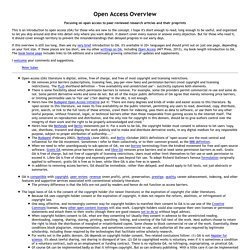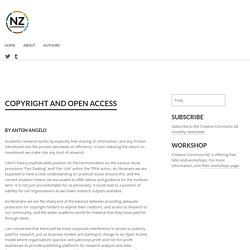

Creative Commons Aotearoa New Zealand. WhatIsOA. CopyrightAsiaPacific Ch14. Open Access Overview (definition, introduction) Peter Suber First put online June 21, 2004.

Last revised December 5, 2015. Suggested short URL for this page = Peter Suber Director, Harvard Office for Scholarly CommunicationDirector, Harvard Open Access ProjectFaculty Fellow, Berkman Center for Internet & Society Senior Researcher, Scholarly Publishing and Academic Resources CoalitionResearch Professor of Philosophy, Earlham Collegepeter.suber@gmail.com This overview is also available in Chinese (October 2011), Czech (December 2013), French (September 2012), German (September 2011), Greek (February 2012), Japanese (January 2013), Polish (July 2015), Romanian (September 2012), Russian (January 2012), Slovenian (July 2005), Spanish (March 2012), and Swahili (December 2015). YouTube. Page. Alternatives to Copyright By Eva Garmpi, LLM candidate KLS LLM Dissertation September 2006 Table of Contents Abstract Copyright law is a sub-division of intellectual property law, a legal device, which is designed to offer protection to original works of authorship that are fixed in any tangible medium of expression.

The foregoing alterations concerning the substance of current copyright law and the many economic and social concerns raised within nowadays reality, have called for copyright’s redefinition and reformation, or even to an extreme, for copyright’s abolition. In approaching the matter, I will first consider the reasons for which copyright alternatives have been a hot topic of late. Acknowledgements I would like to express my gratitude to all these people who helped in the materialisation of this paper. Thank you all very much. Introduction Copyright protection basically involves the expression of an idea, not the idea itself[4]. Chapter 1 Changes in copyright’s duration Chapter 2. Copyright and Open Access - NZ Commons. By Anton Angelo Academic research works by explicitly free sharing of information, and any friction introduced into the process decreases its efficiency, in turn reducing the return on investment we make into any kind of research.

I don’t have a sophisticated position on the harmonisation on the various reuse provisions “Fair Dealing” and “Fair Use” within the TPPA actors. As librarians we are expected to have a clear understanding on practical issues around this, and the current situation means we are unable to offer advice and guidance for the medium term. It is not just uncomfortable for us personally; it could lead to a position of liability for our organisations as we make research outputs available. As librarians we are the sharp end of the balance between providing adequate protection for copyright holders to exploit their creations, and access to research to our community, and the wider academic world for material that they have paid for through taxes. 1 What Is Software Freedom? Study of the GNU General Public License (herein, abbreviated as GNU GPL or just GPL) must begin by first considering the broader world of software freedom.

The GPL was not created in a vacuum. Rather, it was created to embody and defend a set of principles that were set forth at the founding of the GNU Project and the Free Software Foundation (FSF) – the preeminent organization that upholds, defends and promotes the philosophy of software freedom. 7 Things You Should Know About Creative Commons. Creative Commons is an alternative to traditional copyright, devel¬oped by a nonprofit organization of the same name.

By default, most original works are protected by copyright, which confers specific rights regarding use and distribution. Creative Commons allows copyright owners to release some of those rights while retaining others, with the goal of increasing access to and sharing of intellectual property. The "7 Things You Should Know About... " series from the EDUCAUSE Learning Initiative (ELI) provides concise information on emerging learning practices and technologies. Each brief focuses on a single practice or technology and describes what it is, where it is going, and why it matters to teaching and learning. Use "7 Things You Should Know About... " briefs for a no-jargon, quick overview of a topic and share them with time-pressed colleagues.
Module 6: Creative Approaches and Alternatives - Copyright for Librarians. Learning objective Traditional rights management often involves an exclusive assignment of all of the rights associated with a copyright from the author to a publisher.

The publisher then makes copies and distributes the work to the public for a fee. By contrast, free, libre and open access models disseminate works at no cost to the user. This module describes these alternative approaches, focusing on Creative Commons licensing and Open Access policy for scientific publications. Case study Angela writes Nadia the following email: “A professor at our university is the author of one of the articles I want to include in the course pack. How should Nadia respond? Lesson Introduction: Physical and Digital Commons Physical objects are often scarce and rivalrous. By contrast, the intellectual products governed by copyright law typically are nonrivalrous.
The wide distribution of intellectual products is socially beneficial. In a growing number of contexts, reformers are challenging that answer.